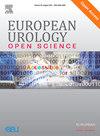ProstaPilot:双参数磁共振成像与前列腺特异性抗原作为前列腺癌筛查试验的比较研究
IF 3.2
3区 医学
Q1 UROLOGY & NEPHROLOGY
引用次数: 0
摘要
背景和目的我们的目的是比较捷克人群中双参数磁共振成像(bpMRI)和前列腺特异性抗原(PSA)筛查途径对临床显著性前列腺癌(csPC)的检出率,捷克人群的机会性PSA检测率很高(目标年龄组为45%)。方法:在2022年5月至2023年5月期间,423名年龄在50-69岁之间的男性通过志愿者招募入组,接受了PSA检测和前列腺bpMRI检查。阳性结果定义为PSA≥3 μg/l或前列腺影像报告和数据系统评分为4-5。检测结果呈阳性的患者接受进一步评估,包括mri靶向活检和系统的12芯活检。csPC定义为国际泌尿病理学会分级组≥2级的任何癌症。在423名男性中,35名(8.3%)至少有一项筛查试验阳性。基于psa的途径确定了25名男性(5.9%),而基于mri的途径确定了16名男性(3.8%)怀疑PC,有可能减少36%的活检次数。随后的活检显示7名男性(1.7%)PSA检测阳性,14名男性(3.3%)MRI阳性。PSA途径的非显著PC和csPC率分别为1.0% (n = 4)和0.7% (n = 3), MRI途径的非显著PC和csPC率分别为1.7%和1.7% (n = 7)。结论和临床意义在高度预先筛选的人群中,与基于psa的诊断相比,bpMRI可能增加csPC的检出率,同时减少所需的活检次数。然而,bpMRI也可能略微增加1级组癌症的检出率。患者总结:我们比较了50-69岁男性前列腺癌的PSA(前列腺特异性抗原)血液检测和MRI扫描(磁共振成像)检测。我们发现,核磁共振扫描可以减少癌症诊断所需的活检次数,同时提高重要癌症的检出率。本文章由计算机程序翻译,如有差异,请以英文原文为准。
ProstaPilot: A Comparative Study of Biparametric Magnetic Resonance Imaging Versus Prostate-specific Antigen as a Screening Test for Prostate Cancer
Background and objective
Our aim was to compare detection rates for clinically significant prostate cancer (csPC) between biparametric magnetic resonance imaging (bpMRI) and prostate-specific antigen (PSA) screening pathways in the Czech population, which has a high prevalence of opportunistic PSA testing (45% in the target age group).
Methods
Between May 2022 and May 2023, 423 men aged 50–69 yr who were enrolled via volunteer-based recruitment, underwent both PSA testing and bpMRI of the prostate. Positive results were defined as PSA ≥3 μg/l or a Prostate Imaging-Reporting and Data System score of 4-5. Those with positive tests were referred for further evaluation, including an MRI-targeted biopsy and a systematic 12-core biopsy. csPC was defined as any cancer of International Society of Urological Pathology grade group ≥2.
Key findings and limitations
Of the 423 men, 35 (8.3%) had at least one positive screening test. The PSA-based pathway identified 25 men (5.9%), whereas the MRI-based pathway identified 16 (3.8%) with suspicion of PC, with potential to reduce the number of biopsies required by 36%. Subsequent biopsy revealed PC in seven men (1.7%) with a positive PSA test and 14 men (3.3%) with positive MRI findings. Nonsignificant PC and csPC rates were 1.0% (n = 4) and 0.7% (n = 3) for the PSA pathway, and 1.7% and 1.7% (n = 7) for the MRI pathway, respectively.
Conclusions and clinical implications
In a highly prescreened population, bpMRI may increase the csPC detection rate while reducing the number of biopsies needed in comparison to PSA-based diagnosis. However, bpMRI may also slightly increase the detection of grade group 1 cancers.
Patient summary
We compared a blood test for PSA (prostate-specific antigen) and an MRI scan (magnetic resonance imaging) for detection of prostate cancer in men aged 50–69 years. We found that MRI scans may reduce the number of biopsies that need to be performed for cancer diagnosis while increasing the detection rate for cancers that are significant.
求助全文
通过发布文献求助,成功后即可免费获取论文全文。
去求助
来源期刊

European Urology Open Science
UROLOGY & NEPHROLOGY-
CiteScore
3.40
自引率
4.00%
发文量
1183
审稿时长
49 days
 求助内容:
求助内容: 应助结果提醒方式:
应助结果提醒方式:


